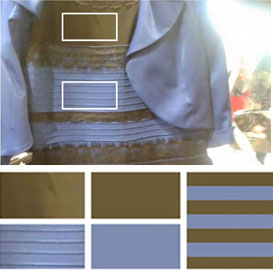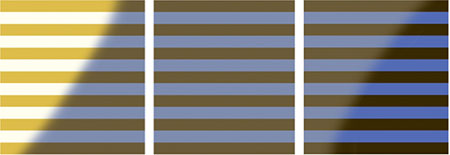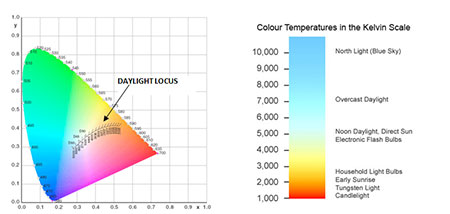Sophie Wuerger is Professor of Visual Neuroscience in the Institute of Psychology, Health and Society:
“It was a good weekend for vision science. Two days ago a picture of a dress was posted on the internet, which was perceived by some people as gold/white and by others as black/blue.
This discrepancy in perceived colour contrast sparked an unprecedented interest among vision scientists. The reason being that the dress is such a great example demonstrating how the visual brain works and the different levels of visual processing.
Social media enabled a rapid exchange of different hypotheses and immediate, albeit poorly controlled, data collection. Now, 48 hours later a consensus has emerged.
As my colleague Paul Knox has pointed out, the visual brain does not encode wavelength. Receptors in the retina under-sample the wavelength spectrum: instead of encoding the light reflected at each wavelength, only three numbers are encoded, namely the output of each of the three receptors.
Any object we perceive in the real world is illuminated and the colour signal that reaches our eye is the product of the reflectance (property of the object) and the prevailing illumination. Since the visual system is interested in the real colour of object (i.e. its reflectance), it needs to ‘discount’ the illumination.
In some instances, the object might be partly covered by a shadow as shown in the figure below (source: New York Times). The visual system needs to establish which lightness/colour changes in the retinal image of the object are due to material properties of the object and which ones are incidental, that is, caused by non-uniform illumination sources or shadows.
In the example above, some people might interpret the change in lightness as being caused by a shadow falling on the object; or as non-uniform illumination. Depending on the particular interpretation, different compensation strategies may be applied to the image to recover the material properties of the object.
If there are too few cues in the image, the prevailing illumination cannot be estimated reliably.
In #dressgate, there is plenty of ambiguity, as to where the light source is located, the chromaticity of the illumination (direct or indirect sunlight; office light, LEDs etc), whether the dress is in the shadow etc.
There was no other object in the image, such as human skin, which would provide an anchor point for estimating the illumination or the shadows.
It is the paucity of reliable cues that is likely to lead to the ambiguity in the interpretation and to large individual differences in the perceived colour of the dress.
If we accept that it is estimation of the illumination/shadows that plays a major role in generating these different percepts (other factors such as attention are also likely to play a role), then we need to take a closer look at the mechanisms underlying this estimation.
The assumptions the visual brain makes about illumination sources and shadows can be shaped by experience, which may contribute to individual differences.
We also know that people are particularly poor in discriminating colour changes that co-incide with the normal daylight changes (sunrise to sunset; solid line in figure below).
From an evolutionary perspective it makes sense that the human visual brain ‘ignores’ colour variations along the daylight locus (see solid line in figure below) since these changes are not properties of the object but reflect changes in the illumination.
This relative lack of sensitivity along the daylight locus might be useful to maintain a constant perception, but may also contribute to large individual differences and to large differences in the subsequent interpretation of the colour of the object.”
Up to now, all of this is pure speculation. To fully understand #dressgate requires careful experimentation; I am confident that more light will be shed on this problem (excuse the pun) in the forthcoming European Conference of Visual Perception, to be held in Liverpool, August 23-27 2015.
p.s. The true colour of the dress is black/blue.
http://www.nytimes.com/interactive/2015/02/28/science/white-or-blue-dress.html?smid=fb-share&_r=0
http://www.iflscience.com/brain/explaining-perceptions-dress
https://www.facebook.com/notes/facebook-data-science/all-about-that-dress/10152920170998859


